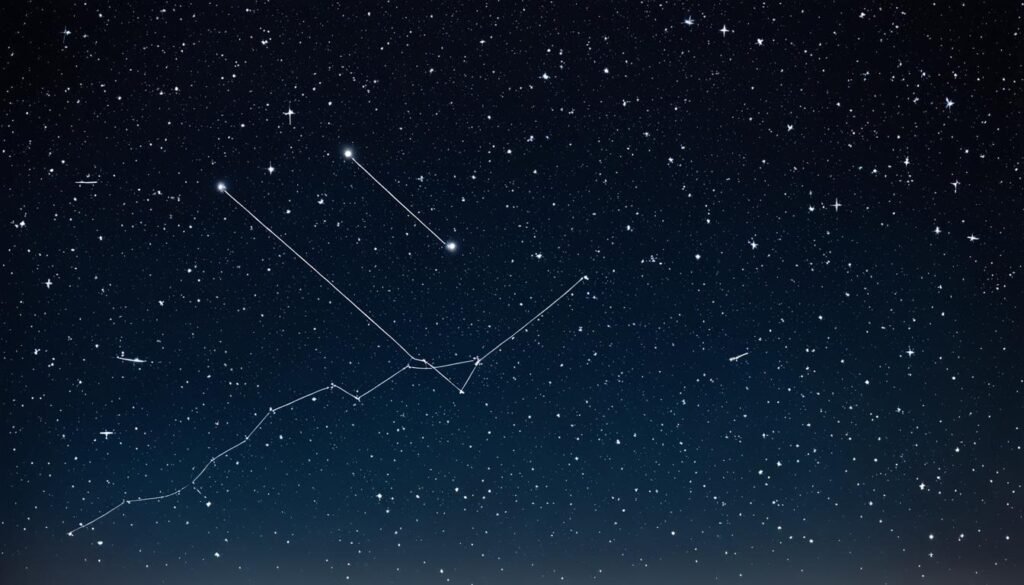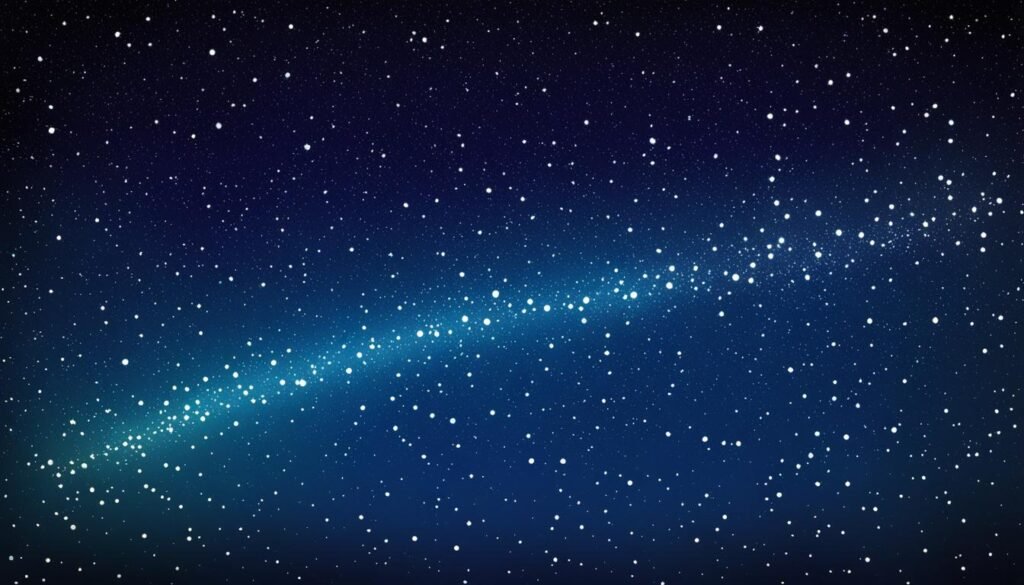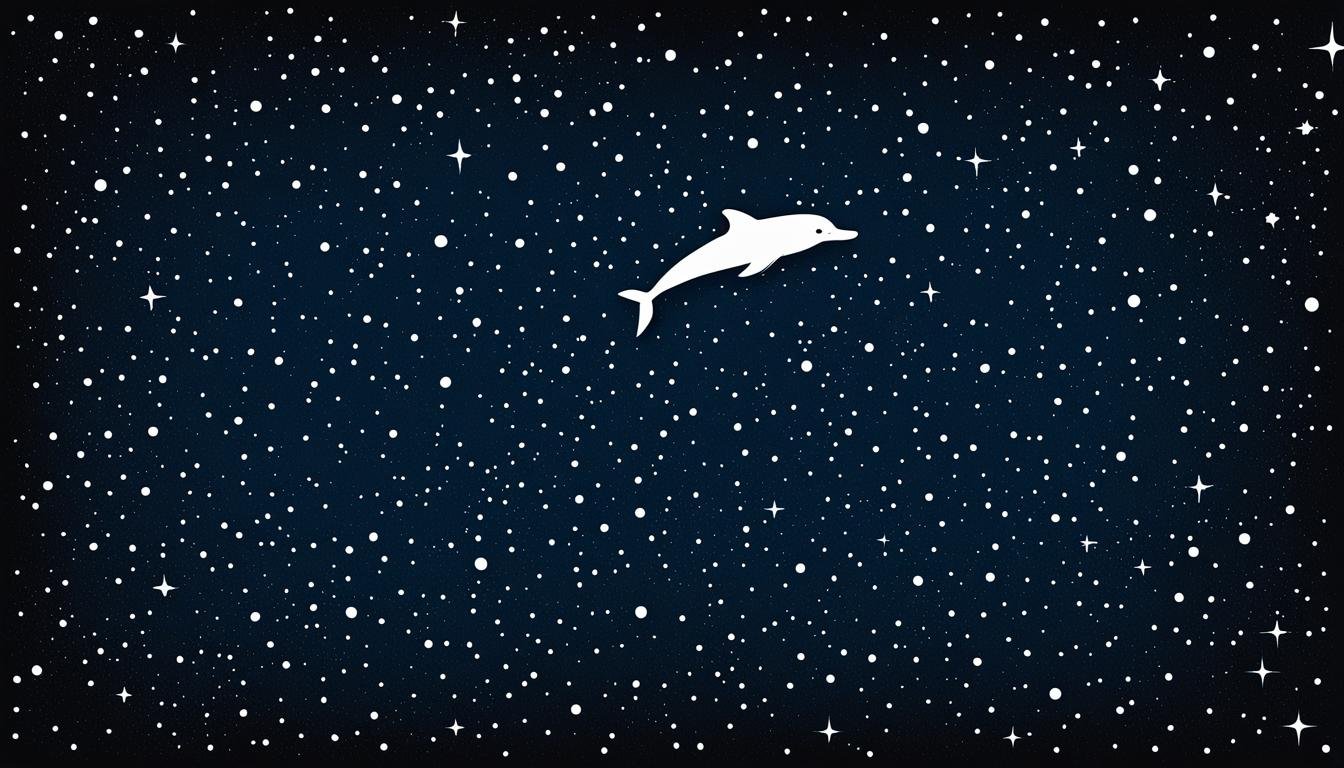| Genitive | |
| Abbreviation | |
| Pronunciation | |
| Main Stars | |
| Brightest Star | |
| Right Ascension | |
| Declination | |
| Sq. Deg. Area | |
| Crosses Meridian | |
| Visible Lat. Range |
Welcome to the celestial journey that takes you through the heart of the night sky—the Delphinus constellation, a symbol of grace and mythological wonder. Known commonly as the Dolphin constellation, Delphinus dances across the northern sky, its stars weaving a tale as old as time itself. Admiring the Delphinus stars, you’ll discover constellation facts that are not just points of light, but echoes of ancient stories and cosmic mysteries.
Named after the Latin term for “dolphin,” this constellation harbors a rich tapestry of history and astronomy. It invites you to gaze upon Job’s Coffin, the distinctive diamond-shaped asterism that has intrigued stargazers since its first recording by the pioneer of star mapping, Ptolemy, in the 2nd century. With principal stars like Rotanev and Sualocin, the Delphinus constellation serves as a beacon for explorers of the night, guiding them across the oceanic expanse of the universe.
Key Takeaways
- Delphinus, a constellation steeped in myth and legend, symbolizes a messenger of the gods and a savior in Greek folklore.
- The constellation is easily identifiable by its unique asterism, Job’s Coffin, which depicts the shape of a dolphin.
- Key stars like Rotanev and Sualocin not only guide us through historical tales but also offer insights into the complexities of celestial bodies.
- Although the constellation is not associated with any meteor showers, it contains several deep sky objects worthy of exploration.
- Delphinus remains an essential figure in understanding the interconnectedness of constellations within the northern sky.
- Learning about Delphinus enhances appreciation for the narratives that have been written in the stars, passed down through generations.
Exploring the Historical Significance of Delphinus Constellation
As you delve into the depths of starlit myths and ancient celestial navigation, the Delphinus mythology unfurls a narrative as captivating as the sea itself. The distinctive shape of this Dolphin star has been a beacon for sky-watchers since antiquity. Found among the Northern Hemisphere constellations, its legacy is richly intertwined with the folklore and science of early astronomy.
Origin of the Name and Mythology
The immortal tale embossed among the stars, Delphinus, hails its name from the Latin “dolphin,” a nod to its storied aquatic counterpart. In one revered legend, this constellation symbolizes the divine dolphin dispatched by Poseidon to court Amphitrite, setting into motion their fabled romance. Similarly, Apollo commemorated the dolphin that heroically rescued the eminent lyre player Arion through its celestial image. These legends are not mere tale; they resonate the human propensity to assign meaning to the patterns we discern in the night sky.
Role in Ancient Greek Astronomy
Delphinus’ position in the firmament was cemented by the esteemed Greek astronomer Ptolemy’s early celestial cataloging. This acknowledgment bestowed upon Delphinus suggests not just Ptolemy’s recognition of its prominence within Greek culture, but likewise its utility in the foundation of western observational astronomy, mapping out a legacy that would be read by the eyes of countless generations of stargazers.
Navigating the Northern Sky
Adrift among the pantheon of Northern Hemisphere constellations, Delphinus is recognized by its genitive form, Delphini, a beacon for those traversing the vast celestial ocean. Spanning an area of 189 square degrees, Delphinus is not the largest constellation, but its distinctive grouping and mythological bearings render it an unmistakable and cherished territory within the arcing nocturnal heavens.
Constellation Delphinus: A Celestial Dolphin
The alluring Delphinus constellation, with its compact and distinctive shape, evokes the majestic image of a dolphin gracefully navigating the celestial sea. As you gaze at the stars, imagine the storybook dolphin frolicking in the vast ocean of space. This tableau is not a lone mythological marvel but a part of the much larger and thematically connected Heavenly Waters family of constellations.
With its inclusion in the Heavenly Waters family, Delphinus shares the stage with other sea-inspired constellations like Carina, which represents the keel of a ship, and Piscis Austrinus, the southern fish. Bound by an aquatic theme, these constellations weave a tapestry of maritime lore and legend across the night sky. In 1922, the International Astronomical Union (IAU) officially designated the abbreviation ‘Del’ for Delphinus, anchoring its place among the stars.
Delphinus is nestled among several constellations, serving as celestial neighbors that provide a framework for locating it in the sprawling sky. Surrounded by Aquarius, Aquila, Equuleus, Pegasus, Sagitta, and Vulpecula, Delphinus emerges as a treasure amidst the cosmic map, easily identified by its unique asterism, despite being devoid of Messier objects—a rarity in the world of astronomy.
- Aquarius – The Water Bearer
- Aquila – The Eagle
- Equuleus – The Little Horse
- Pegasus – The Winged Horse
- Sagitta – The Arrow
- Vulpecula – The Little Fox
Further adding to its allure, this constellation isn’t just a feast for the eyes and the imagination. It is an actual wonderland for exoplanet enthusiasts, as Delphinus claims five stars within its embrace that are known to host planets. Among its starry cohort, the brightest beacon of them all is Rotanev, offering astronomers and stargazers a glinting focal point around which tales of the cosmos revolve.
| Bordered by | Brightest Star | Notable Feature |
|---|---|---|
| Aquarius, Aquila, Equuleus, Pegasus, Sagitta, Vulpecula | Rotanev | Five Known Planets |
Delphinus’s story is one that interweaves the marvels of ancient lore with the unfolding mysteries of the universe. It beckons you to delve deeper into the night sky, seeking out not just stars and planets but the narratives they have carried across millennia. This constellation embodies the wonder of the skies, a testament to the enduring bond between heavens and Earth’s storytellers.
Identifying Delphinus in the Night Sky
Embarking on a star-gazing journey brings its rewards, especially when you’re seeking the dainty constellation of Delphinus. With a mix of history, astronomy, and mythology draped across the sky, pinpointing this enchanting constellation is a celestial treat for avid stargazers and casual observers alike. Let’s delve into the strategies that will guide you in spotting Delphinus among the stars.
Asterism Recognition: Job’s Coffin
Job’s Coffin is not just a strikingly named asterism; it’s your key to unlocking Delphinus’s location in the vast night sky. This asterism is comprised of a diamond-shaped pattern that forms the main part of the “dolphin,” including its celebrated bright stars: Alpha Delphini (Sualocin), Beta Delphini (Rotanev), Gamma, and Delta Delphini. With such distinctive markers, how to find Delphinus becomes simpler, especially on clear summer nights.
Utilizing the Summer Triangle as a Guide
The Summer Triangle, an asterism in its own right, makes for an excellent guidepost when locating the Constellation Delphinus. By drawing an imaginary line from Vega, one of the apex stars of the Summer Triangle, through the star Albireo in Cygnus, you can effortlessly find Delphinus’s tail star, Epsilon Delphini (Aldulfin). This technique is particularly handy when you’re trying to determine Constellation Delphinus visibility among the numerous stars of the summer sky.
Locating Delphinus from Different Hemispheres
Delphinus’s charm isn’t hemispheric-bound; it’s equally visible from both the northern and southern realms of the globe. Whether you are situated in the Northern Hemisphere gazing up on a warm July evening or observing from the Southern Hemisphere during the cooler months, Delphinus makes its presence known. Here’s a handy table to guide you on the best times to catch a glimpse of this aquatic constellation:
| Location | Best Viewing Months | Observation Tips |
|---|---|---|
| Northern Hemisphere | July to October | Look directly overhead in the early night sky |
| Southern Hemisphere | June to September | Scan the northern sky, above the horizon |

As seasons change and the Earth rotates, the visibility of Delphinus shifts too. Nevertheless, with these techniques and a touch of patience, you’ll be enjoying the sights of this celestial dolphin in no time. Remember, the joy is as much in the journey of locating these stars as it is in the final, awe-inspiring view.
The Brightest Stars of Delphinus
Within the sea of stars that make up the night sky, the constellation Delphinus distinguishes itself with a group of luminaries that outshine the rest. This section illuminates the attributes of Delphinus’s most radiant stars, guiding you through the celestial depths where Rotanev, Sualocin, and Aldulfin sail. Their individual characteristics contribute to the overall dolphin star brightness that makes this constellation so captivating to stargazers.
Rotanev – The Luminous Beacon
Known as Beta Delphini, Rotanev serves as a guiding light, a binary star system where two white stars dance in a gravitational embrace. This beacon shines with an apparent magnitude of 3.617, positioned approximately 101 light years from our planet.
Sualocin – A Complex Star System
The complex star system of Sualocin or Alpha Delphini, presents a more intricate cosmic narrative. With a contrastive magnitude of 3.777, this group is anchored by Alpha Delphini Aa, a striking blue-white subgiant that asserts its presence in the night sky.
Aldulfin – The Dolphin’s Tail
Marking the tail of the celestial dolphin, Aldulfin, or Epsilon Delphini, is a blue-white giant that displays variability in its luminosity. This star completes the distinguishable figure of Delphinus and adds to the intrigue with its subtle fluctuations in brightness.
| Star Name | Apparent Magnitude | Distance (Light Years) | Description |
|---|---|---|---|
| Rotanev (Beta Delphini) | 3.617 | 101 | Binary star system; two white stars |
| Sualocin (Alpha Delphini) | 3.777 | Varies | Multiple star system; primary star is a blue-white subgiant |
| Aldulfin (Epsilon Delphini) | Variable | Varies | Blue-white giant exhibiting changes in brightness |
You can witness the splendor of these stars within Delphinus, part of a select assembly shining with a magnitude above 6.5, adorning the celestial aquatic landscape. Whether your interest lies in the mythology they carry or the fascination of their cosmic dance, the stars of Delphinus offer a brilliant display of stellar allure.

Deep Sky Wonders within Delphinus
As you cast your gaze into the northern celestial sphere, Delphinus, known for its narrative steeped in Greek mythology and its prominent stars, entices stargazers with yet another marvelous feature – its deep sky objects. Among these astral beauties are two stellar globular clusters that stand out brilliantly against the cosmos. NGC 6934 presents itself with a resplendent magnitude of 9.75, drawing enthusiasts with its dense core of ancient stars. Similarly, NGC 7006, albeit fainter at a magnitude of 10.46, offers a captivating view, located farther away on the outskirts of the galactic halo, both exemplifying the intriguing NGC objects in Delphinus.
Delving deeper into Delphinus’s celestial vault, you will encounter the ethereal glow of two planetary nebulae. NGC 6891 radiates with the complexity of its gaseous layers, a testament to the life cycle of stars. More prominently, NGC 6905, also known as the Blue Flash Nebula, catches the eye with its exceptional coloration. This azure gem, reminiscent of a fleeting luminous burst, adds a touch of splendor to the Delphinus constellation, making it a sought-after spectacle for your stargazing adventures.
The lure of Delphinus is not merely limited to these highlighted features. The constellation is a veritable trove of 31 cataloged celestial entities which include a tapestry of galaxies and nebulae, each adding their own unique brush strokes to the astronomical masterpiece. Your journey through the night sky is enriched by these Delphinus deep sky objects, providing a window into the universe’s grandeur and an endless source of wonderment for observers and astronomers alike.
FAQ
What is the Delphinus constellation?
The Delphinus constellation is a small constellation situated in the northern sky, named after the Latin term for “dolphin.” It is known for its prominent diamond-shaped asterism, Job’s Coffin, and is associated with fascinating myths from Greek mythology.
How did the Delphinus constellation get its name?
Delphinus constellation derives its name from the Latin word for “dolphin.” According to Greek mythology, the constellation represents a dolphin that was sent by Poseidon to find his consort Amphitrite or the one that saved the Greek poet Arion, depending on the story.
What are the main stars that form the Delphinus constellation?
The main stars comprising the Delphinus constellation are Sualocin (Alpha Delphini), Rotanev (Beta Delphini), Gamma Delphini, Delta Delphini, which outline the dolphin’s body, and Aldulfin (Epsilon Delphini), which indicates its tail.
Can the Delphinus constellation be seen from both northern and southern hemispheres?
Yes, the Delphinus constellation is visible from both the northern and southern hemispheres, although its visibility may vary depending on the geographical location and the time of year.
What is Job’s Coffin in relation to the Delphinus constellation?
Job’s Coffin is the distinctive asterism within the constellation Delphinus, formed by its brightest stars – Alpha (Sualocin), Beta (Rotanev), Gamma, and Delta Delphini – which create a diamond shape resembling a coffin or the body of the dolphin, depending on the perspective.
How can I locate the Delphinus constellation using the Summer Triangle?
To locate Delphinus using the Summer Triangle, locate Vega and draw an imaginary line through Albireo in the constellation Cygnus. This will lead you to the tail star of Delphinus, Aldulfin (Epsilon Delphini).
What is the significance of the stars Rotanev, Sualocin, and Aldulfin in the constellation Delphinus?
Rotanev, Sualocin, and Aldulfin are the brightest stars in the constellation Delphinus. Rotanev is a binary system, Sualocin is a complex multiple star system, and Aldulfin is a blue-white giant. These stars are central to the constellation’s identification and mythology.
Does the Delphinus constellation contain any deep sky objects?
Yes, the Delphinus constellation is home to several deep sky objects including two globular clusters, NGC 6934 and NGC 7006, and two planetary nebulae, NGC 6891 and the Blue Flash Nebula (NGC 6905).
What is the best time of year to observe the Delphinus constellation?
The constellation Delphinus is most readily observed during the summer months in the northern hemisphere when it is at its highest point in the night sky. However, it can generally be seen throughout the year.
Is there any connection between the stars Rotanev and Sualocin in Delphinus?
Interestingly, the names Rotanev and Sualocin are derived from the Latinized name Nicolaus Venator, which is the reversed form of Niccolò Cacciatore, the former assistant of the famous Italian astronomer Giuseppe Piazzi. The two stars form part of the asterism of Delphinus and are in proximity to each other in the night sky.






